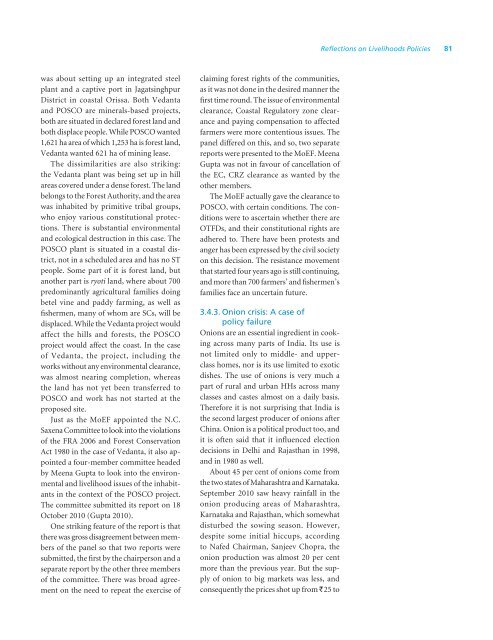SOIL Report 2011 - ACCESS Development Services
SOIL Report 2011 - ACCESS Development Services
SOIL Report 2011 - ACCESS Development Services
- No tags were found...
Create successful ePaper yourself
Turn your PDF publications into a flip-book with our unique Google optimized e-Paper software.
Reflections on Livelihoods Policies 81was about setting up an integrated steelplant and a captive port in JagatsinghpurDistrict in coastal Orissa. Both Vedantaand POSCO are minerals-based projects,both are situated in declared forest land andboth displace people. While POSCO wanted1,621 ha area of which 1,253 ha is forest land,Vedanta wanted 621 ha of mining lease.The dissimilarities are also striking:the Vedanta plant was being set up in hillareas covered under a dense forest. The landbelongs to the Forest Authority, and the areawas inhabited by primitive tribal groups,who enjoy various constitutional protections.There is substantial environmentaland ecological destruction in this case. ThePOSCO plant is situated in a coastal district,not in a scheduled area and has no STpeople. Some part of it is forest land, butanother part is ryoti land, where about 700predominantly agricultural families doingbetel vine and paddy farming, as well asfishermen, many of whom are SCs, will bedisplaced. While the Vedanta project wouldaffect the hills and forests, the POSCOproject would affect the coast. In the caseof Vedanta, the project, including theworks without any environmental clearance,was almost nearing completion, whereasthe land has not yet been transferred toPOSCO and work has not started at theproposed site.Just as the MoEF appointed the N.C.Saxena Committee to look into the violationsof the FRA 2006 and Forest ConservationAct 1980 in the case of Vedanta, it also appointeda four-member committee headedby Meena Gupta to look into the environmentaland livelihood issues of the inhabitantsin the context of the POSCO project.The committee submitted its report on 18October 2010 (Gupta 2010).One striking feature of the report is thatthere was gross disagreement between membersof the panel so that two reports weresubmitted, the first by the chairperson and aseparate report by the other three membersof the committee. There was broad agreementon the need to repeat the exercise ofclaiming forest rights of the communities,as it was not done in the desired manner thefirst time round. The issue of environmentalclearance, Coastal Regulatory zone clearanceand paying compensation to affectedfarmers were more contentious issues. Thepanel differed on this, and so, two separatereports were presented to the MoEF. MeenaGupta was not in favour of cancellation ofthe EC, CRZ clearance as wanted by theother members.The MoEF actually gave the clearance toPOSCO, with certain conditions. The conditionswere to ascertain whether there areOTFDs, and their constitutional rights areadhered to. There have been protests andanger has been expressed by the civil societyon this decision. The resistance movementthat started four years ago is still continuing,and more than 700 farmers’ and fishermen’sfamilies face an uncertain future.3.4.3. Onion crisis: A case ofpolicy failureOnions are an essential ingredient in cookingacross many parts of India. Its use isnot limited only to middle- and upperclasshomes, nor is its use limited to exoticdishes. The use of onions is very much apart of rural and urban HHs across manyclasses and castes almost on a daily basis.Therefore it is not surprising that India isthe second largest producer of onions afterChina. Onion is a political product too, andit is often said that it influenced electiondecisions in Delhi and Rajasthan in 1998,and in 1980 as well.About 45 per cent of onions come fromthe two states of Maharashtra and Karnataka.September 2010 saw heavy rainfall in theonion producing areas of Maharashtra,Karnataka and Rajasthan, which somewhatdisturbed the sowing season. However,despite some initial hiccups, accordingto Nafed Chairman, Sanjeev Chopra, theonion production was almost 20 per centmore than the previous year. But the supplyof onion to big markets was less, andconsequently the prices shot up from `25 to














